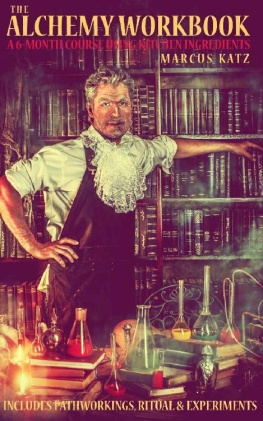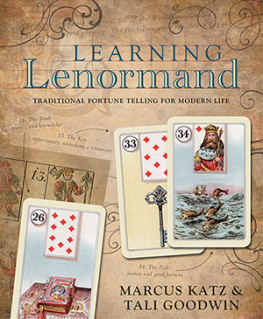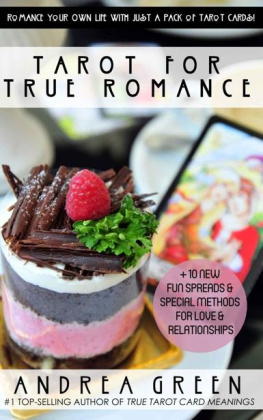
THE GARDEN OF CREATION:
Gated Spread Book 5
Explore Your Creativity
By Tali Goodwin & Marcus Katz
Copyright Tali Goodwin & Marcus Katz, 2013
Published by Forge Press, Keswick
All rights reserved.
WHAT OUR STUDENTS SAY
I am extremely thankful for these exercises. I feel like I could spend years contemplating these results and still not get to the bottom of the insight I have gained.
C.C.
This exercise as well as the others have spoken volumes. Thank you for sharing this experience with us.
R. G.
Incredible knowledge so easily shared This has been a journey in which I have learned a lot of new things and feel very satisfied.
L. J.
Very moving and effective. I cannot wait for the next gates!
Y.
I suddenly realized I have been dreaming like crazy since I started these exercises! Very intuitive stuff about my situation, and about my Tarot!
L.
We have used real-life examples and authentic feedback throughout this series, anonymously, from our students in Tarot-Town. We thank them for their engagement with these experiences over the years.
About the Authors
You know, the Tarot is a Blank Bible for everyone to fill in .
Goodwin to Katz, Typical Conversation.
Tali Goodwin is the co-author of award-winning and #1 best-selling Tarot books, including Around the Tarot in 78 Days, Tarot Face to Face, and Learning Lenormand. She is also a leading Tarot researcher and is credited with the discovery of A. E. Waites second tarot deck, kept secret for a century, published as Abiding in the Sanctuary . She has also uncovered and published the Original Lenormand deck, and with co-author Derek Bain, the original Golden Dawn Tarot images in A New Dawn for Tarot . Her research into the life of Pamela Colman-Smith with new photographs will be published as The Secrets of the Waite-Smith Tarot by Llewellyn Worldwide in Spring 2014. She is co-Director of Tarosophy Tarot Associations (Worldwide) and organizes the international tarot conventions, TarotCon.
Marcus Katz is author of the ground-breaking Tarot book and teaching system, Tarosophy , and is the co-founder of Tarosophy Tarot Associations (Worldwide). In addition to Tarot books with Tali Goodwin, he is the author of The Magister , an 11-volume opus on the Western Esoteric Initiatory System, The Magicians Kabbalah , and the forthcoming Path of the Seasons . He teaches students privately in the Crucible Club , available by application.
Contents
WHAT OUR STUDENTS SAY
About the Authors
Contents
Preface
What is the Tarot?
What Are The Top 10 Wrong Ideas About Tarot?
The Tarot & Creativity
Chapter 1: Garden Plan
Chapter 2: Stepping Stones
Chapter 3: Talking Fountain
Chapter 4: Labyrinth
Conclusion
Bibliography
Websites & Resources
Kindle Tarot Books & Series
Preface
The business of making up stories has been going on a long time.
Alexander Steele (ed.) Writing Fiction , p. 2
You are about to go on a journey and experience magical creativity.
Grab a Tarot deck, and we are good to go!
The purpose of Gated Spreads is to overturn the common use of Tarot cards as a means of telling the future, or providing a brief insight into our life and motivations and hence our future possibilities. The teaching of Tarosophy encourages the use of Tarot as a divine language; one which connects us to the deeper world underneath the apparent one which we often take for granted. A gated spread requires you to take action in your life, from which change emerges naturally. This is not the empty promise of a feel-good self-help book, but a call to action your action to change your life through Tarot.
Our Gated Spread experiences have been offered for several years to the public, and now for the first time we provide them in handy self-study packages on Kindle. In each of these individual books, you can experience shamanism, relationship and romance insight, creativity, alchemy, and even delve into your ancestry, all using just a tarot deck.
We have also ensured that this is not a book of fictional examples that sound too good to be true. Our books are based only on real-life testing and the actual experience of real people like you, encountering magick often for the first time. We have taught these methods and ran workshops and gated spread weeks for many years, and have hundreds of experiences which have constantly shaped what you are about to experience for yourself.
This book is ideal for first time users of Tarot or the experienced reader who is looking to activate the tarot in their life. We have ensured that you are given the necessary instructions and clarifications (from our previous teaching and feedback given by students) to experience true magick in your time using this book.
Before you begin, you may wish to join our free Facebook group if you have any questions about Tarot, and also download our free keyword guide to tarot cards and standard spreads from our site:
www.mytarotcardmeanings.com
What is the Tarot?
The tarot as most commonly recognized is a family of card decks, most often 78 cards divided into four suits of 14 cards (10 numbered cards and 4 Court cards for each suit) and 22 Major cards. There are presently about 1,000 different decks in print or circulation, and many more out-of-print, rare and collectable decks.
Although it can be proven that the tarot was developed in the early 15th century, a lot of books still suggest that it was used by the ancient ... and then provide lists of the unproven, non-factual ideas which results in a conflation of tarot and those very ideas.
The earliest names for the tarot are Italian. Originally the cards were called carte da trionfi (cards of the triumphs), but around 1530 A.D. (about 100 years after the origin of the cards) the word tarocchi began to be used to distinguish the tarot cards from a new game of triumphs or trumps then being played with ordinary playing cards.
You are actually seeing in the cards some direct examples of the triumphs the procession of floats common at festivals in Italy at the time particularly in such cards as The Chariot and the Court cards. There is even a Christian tarot in the Victoria and Albert Museum in London; the cards were used to depict virtues, the liberal arts and sciences, and other aspirational notions from their earliest development. In fact, it could be said that the cards were originally educational or self-development tools, although that could also be debatable.
There is no evidence that the tarot were used by gypsies, originated in Egypt or were used for divination prior to the 1700s, despite popular occult lore that the cards have embodied ancient teaching from time immemorial. It was not until a pseudo-connection between the Hebrew letters and the tarot was published in 1781 by Comte de Mellet, in Antoine Court de Geblins Le Monde Primitif that esoteric interest began to appropriate the cards to embody occult teaching.
The earliest list of the 22 cards which have become known as the Major Arcana is given in a sermon against their use by a monk writing in Latin around 1450-1470 A.D. This sermon is sometimes called the Steele Sermon as it belongs to the collection of Robert Steele.
[This above section which we think is so important to teach is repeated in each booklet in this series, and is an extract from Tarosophy , by Marcus Katz].
Which Tarot Deck is Best for This Gated Spread?
Our students have used a range of decks for this experience, and of course the standard Waite-Smith is a favorite. However, students have used these decks with particularly good results:
Next page













